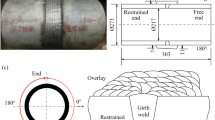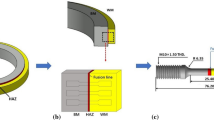Abstract
In general industry, especially in the nuclear industry, welding overlay repair is an important repair method mainly used to rebuild piping systems suffering from intergranular stress-corrosion cracking (IGSCC).
The pipe surface is mechanically ground to obtain a smooth surface after the welding overlay repair. A better understanding of the effect of repair and grinding processes on the residual stresses at the surface of weld overlay is required. To obtain this understanding, it is necessary to measure directly the distribution of residual stresses on the specimen. It is expected that compressive residual stress should be induced at the inner wall surface of the pipe for prevention of IGSCC.
The performance evaluation of welding overlay repair relies on whether or not the level and characteristic of the residual stress can be measured accurately. In this study, the hole-drilling strain-gage method, using the incremental drilling technique, was adopted to estimate the residual stresses on the inner and outer walls of the weld overlay pipe. The experimental results indicate that the residual stress at the pipe inner surface is compressive while that of the outer surface is tensile. Also, it is found that the depth affected by grinding is about 1.016 mm.
Similar content being viewed by others
References
N.R.C., Technical Report on Material Selection and Processing Guidelines for BWR Coolant Pressure Boundary Piping, NUREG-0313 (1988).
Park, J., Kupperman, D. andSchack, W., “Examination of Overlay Pipe Weldments Removed from Hatch-2 Reactor,”Argonne Nat. Lab., Argonne, IL (1984).
Pitcairn D.R., “Advances in Weld Overlay Repair Technology,” Nutech Paper (1983).
Riccardella, P.C., Pitcairn, D.R., Gannuzzi, A.J. andGerber, T.L., “Weld Overlay Repairs from Conception to Long-term Qualification,”Int. J. Press. Vess. and Piping,34,59–82 (1988).
Mathar, J., “Determination of Initial Stresses by Measuring the Deformation Around Drilled Holes,”Trans. ASME,56,249–254 (1934).
Rendler, N.J. andVigness, I., “Hole-drilling Strain-gage Method of Measuring Residual Stresses,”Experimental Mechanics,6,577–586 (1966).
Schajer, G.S., “Application of Finite Element Calculations to Residual Stress Measurement,”J. Eng. Mat. and Tech.,103,157–163 (1981).
Flaman, M.T., andManning, B.H., “Determination of Residual-Stress Variation with Depth by the Hole-drilling Method,”Experimental Mechanics,25,205–207 (1985).
Nickola, W.E., “Practical Subsurface Residual Stress Evaluation by the Hole-Drilling Method,” Proc. 1986 SEM Spring Conf. on Exp. Mech., 47–58 (1986).
ASTM E873-89, Standard Test Method for Determining Residual Stresses by the Hole-Drilling Strain-Gage Method (1989).
Hucek, H.J., Structural Alloys Handbook, Battelle Columbus Lab. (1983).
IHI, Weld Overlay Pipes, Ishikawajima Harima Heavy Industries Co. Ltd. Japan, Maintenance Engineering Dept., Nuclear Power Div. (1989).
Yen, Hung Ju, “The Measurement of Residual Stresses Using the Hole Drilling Method Associated with Strain Gage,”J. NDT, Republic of China Soc. for Nondestructive Testing,9,36–41 (1991).
Measurement Group Inc., “Measurement of Residual Stresses by the Hole-Drilling Strain-Gage Method,”Tech Note TN-503-3, Measurement Group Inc., Raleigh, NC (1988).
Yen, H.J., Chen, L.J., Chen, J.T. andLin, Mark C.C., “Measurement of Residual Stresses at External Surface of Weld Overlay Piping Component,”J. NDT, Republic of China Soc. for Nondestructive Testing,10,52–60 (1992).
Mills, B.E., Personal Communication, Structural Integrity Measurements, Applied Mechanics Section, Mech. Res. Dept., Ontario Hydro Research Division, Toronto, Ontario, Canada (1992).
Watanabe, T., Personal Communication, Inspection and Certification Dpt., High Pressure Gas Safety Institute of Japan, Minato-Ku, Tokyo, Japan (1992).
Lai, G.Y., High-Temperature Corrosion of Engineering Alloys, ASM Int., 15–46 (1990).
Yen, H.J., Chen, L.J., andLin, Mark C.C., “Analysis of Residual Stress on the Inner Wall of Weld Overlay Tube,”J. Welding and Cutting, Welding Soc. of the Republic of China,2,25–31 (1992).
Author information
Authors and Affiliations
Rights and permissions
About this article
Cite this article
Yen, H.J., Lin, M.C.C. Measurement of residual stress in the weld overlay piping components. Experimental Mechanics 35, 89–96 (1995). https://doi.org/10.1007/BF02326465
Received:
Revised:
Issue Date:
DOI: https://doi.org/10.1007/BF02326465




